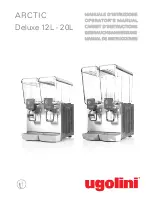
Data Port Output
67
Cat. No. 01024821
Appendix C Data Port Output
Culligan Smart Controller—Data Port Output
The Smart Controller (GBE) is used to control water softeners, filters and commercial RO systems. This controller has the
ability to provide status messages to a customer’s equipment using RS-232 and RS-485 communication protocols. These
protocols are commonly used to send information from the Smart Controller to either a customer’s PC or to a building
management system or programmable logic controller (PLC). The information is one way in that the Smart Controller can
send this information out, but the Smart Controller cannot receive or respond to any commands sent into the communica-
tion port. The Smart Controller sends a status message every 60 seconds. The information is send as a short text (ASCII),
comma separated string of letters and numbers.
The information contained in the status message depends upon what type of equipment is being controlled by the GBE.
Single Water Softener or Filter controlled by the Smart Controller
The format of the status message is: CULL,A,B,C,D,E,F,G
Example: CULL,00016524,000051.5,1,00000000,0x0000,1,0329101314
Where the values for the fields A thru F are as follows:
A = total gallons since new
B = current flow rate in gallons per minute (57.2 means 57.2 gallons per minute )
C = Current Status Indicator (0 = initialization, 1=service, 2=prerinse, 3=regen, 4= standby)
D = capacity remaining in gallons
E = Error Flag (see below)
F = 1
G = A ten-digit number representing the date and time (24-hour format)
Error Bit
Meaning
0
Internal Valve Leak
1
Salt Bridging Detected
2
Brine Line Blocked
3
Brine Tank Overfill Error
4
Replace Media Filter
5
No RF Remote Signal
6
AquaSensor Salt Error (possibly low salt or failed eduction)
7
Motor Homing Error
8
Motor Position Sensor Error
9
Low Salt Level in Brine Tank
10
(not used)
11
AquaSensor Probe Fault (probe has failed, not plugged in or AquaSensor transformer failed)
12
Less than 14 Days Salt
The error flag is sent as a hexadecimal number in the format 0xWXYZ as follows:
W
X
Y
Z
15
14
13
12
11
10
9
8
7
6
5
4
3
2
1
0
Each error bit is either 0, meaning that this error is NOT present, or 1, meaning that this error IS present. Each of the four-
bit sections (W, X, Y and Z) are then combined into a four digit binary word which is converted to a hexadecimal digit.
As an example, if there are no errors present, then the value would be 0x0000.
If there were a ‘Replace Media Filter’, ‘Aquasensor Salt Err’ and ‘Motor Position Sensor Error’ present then bits 4, 6 and 8
would be set to 1 and all other bits would be 0, respectively.







































